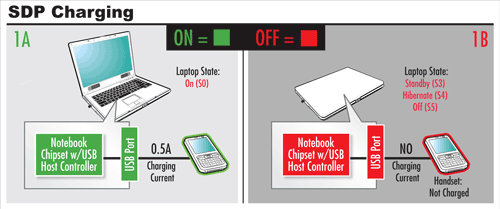Enabling all-the-time USB charging in PCs, laptops
A USB charger controller brings greater flexibility and efficiency to USB-based charging in a cost-effective and reliable manner
BY ABDULLAH RAOUF
Senior Product Marketing Manager,
Pericom
www.pericom.com
With USB serving as the primary data interface for most portable electronics devices today, many manufacturers are looking to also leverage USB as a charging technology. This not only simplifies device charging and allows users to charge from any standard USB port, it substantially reduces system cost since there is no need for a secondary power connector in the device or a separate wall charger.
USB, however, is not without its challenges as a universal charging technology. For example, many users charge their cell phones and media players by plugging them into their PC or laptop overnight. With a standard USB port, the computer must be active and consume an estimated 40+ W all night long. Standard USB ports also limit charge current to 500 mA, increasing overall charge time. Furthermore, cell phone manufacturers have begun to use communication protocols between chargers and batteries to prevent unauthorized chargers from supplying too much current and damaging devices. Unfortunately, these protocols also prevent devices from being plugged into “dumb” hub ports to be charged.
All-the-time charging
The industry’s top notebook manufacturers have begun implementing methods for enabling charging of devices without having to turn on a laptop or PC. Known by names such as “Power Nap” or “Sleep and Charge,” the ability to charge devices all the time is becoming an essential feature in computers. With such technology:
A laptop can charge devices in standby mode (S3), when hibernating (S4), or even when turned off (S5).Charging circuitry consumes less than 3 mW (for example, compared to 40+ W to run the entire system) for a greener approach to charging.More efficient conservation of limited laptop battery reserves enables travelers, for example, to keep an iPad or cell phone fully charged during an entire extended plane trip.The charging process is simplified. For example, users don’t have to wait minutes for their computer to boot up to start charging a device, nor does charging stop when the computer drops into hibernate mode.
Through the use of a USB charger controller, PC and laptop manufacturers can bring greater flexibility and efficiency to USB-based charging in a cost-effective and reliable manner.
Enabling the functionality
The USB specification defines charging of devices through a standard downstream port (SDP). Each SDP can supply up to 500-mA charging current per attached device. In addition, SDP-based controllers are required to enumerate external USB devices prior to enabling charging to occur. This requires the USB host controller to be active. In PC architectures, this USB controller is integrated onto major PC chipsets, thereby forcing the entire system to be fully powered when charging (see Fig. 1a ). As a consequence, devices can only be charged when the notebook is active (S0) and consuming power at its full rate (see Fig. 1b ).
To enable “charging all the time” functionality, developers can place a USB charger controller such as one from Pericom’s PI5USBxxx family in-line between the USB host controller and the USB port. The USB charger controller passes all data through transparently while enhancing the users charging experience.
When the system is active, the USB charger controller can configure the USB port to behave as a charging downstream port (CDP), a new port definition recently added to the USB spec. Through this charging scheme, users can experience reduced charging times when the system is on and a CDP enabled USB device is connected to the PC.
As shown in Fig 2a , the charging current can extend beyond 1.5 A vs only 500 mA when the port behaves as an SDP only. As charge time is based on the charging current, this enables significantly faster charging of devices compared to an SDP-only implementation. Since fast charging time is a primary concern for many users, this is a high-value feature.
In addition to faster charging when the system is in S0 state, a USB charger controller can also support continuous charging even as the system changes to standby mode (S3), hibernate mode (S4), or turned off. This is due to the fact that a USB charger controller does not require enumeration to recognize when a device has been plugged in, and can operate without the USB controller (that is, system chipset) being active. The USB charger controller will manage all communication required to setup the dedicated charging link.
Using a USB charger controller, it is possible to implement charging-all-the-time in a power-efficient manner. A USB charger controller draws less than 3 mW (not counting charging current) to operate. Even over the course of an entire day, this represents very little power overhead. In addition to providing higher charging current and faster charging, USB charger controllers enable greater ease of use and flexibility since users can charge their portable devices without having to worry about whether their computer is turned on or not.
An optimal design is shown in Fig. 2. When the PC or laptop is in S0 state (fully powered on) and needs to support data transfers, the USB port operates in CDP mode with a charging current boosted above 1.5 A when a CDP enabled device is connected. When the PC is changed to S3, S4, or S5 states (standby, hibernate, or fully powered off), the USB charger controller switches to dedicated charging mode and independently enables the link to provide between 1.8 and 5 A for accelerated charging.
Intelligent charging
Over current has long been a significant problem for handset manufacturers. To provide faster charging, some aftermarket charger manufacturers have designed their chargers to exceed SDP charging current limits, which can damage the charger, handset, and USB hub. To prevent handsets from drawing too much current through these fast chargers, intelligence has been added to the charging process using communication protocols to enable a manufacturer’s charger to authenticate itself to the handset as a known and trusted source. Non-authorized chargers are not supported to prevent the possibility of providing too much current to devices.
This added intelligence, however, creates difficulties when charging using USB. Supporting communication protocols adds complexity to the overall USB charger design and introduces interoperability issues as well, since charging protocols vary from phone to phone. To serve as a universal charging port, however, the USB port must support all of the available charging protocols. This requires the charging port to first identify the device brand and type to determine which protocol to use. Next the port must notify the handset as to which current levels it supports. The handset then acknowledges the amount of current it wants to draw. Only then will the handset start to draw power.
Device identification mechanisms can be implemented within the USB charger controller to automatically select the appropriate charging protocol for a device when it is connected for charging. Since the USB charger controller also handles all charging protocol communications, the port can serve as a universal charging port with no modification to the USB protocol stack on the host. This results in an architecture that is compact, self-contained, and straightforward to implement.
Even with integrated protocol support, a USB port still needs to protect the computer and charging device from over current conditions such as shorts and noncompliant/faulty devices which try to draw more than the agreed upon current. Integrated power policing capabilities enable the USB charger controller to shut down if the device has a short and begins to draw a high, continuous current, thus protecting the computer’s internal – and delicate – circuitry.
Users expect to be able to charge their portable devices easily, efficiently, and reliably. USB promises to serve as the industry’s universal charging technology but is often implemented in a way that limits charging current as well as restricts when and even which devices can be charged. Through the use an intelligent USB charger controller, PCs and notebooks can provide charging capabilities all the time, regardless of the computer’s operating state, while enabling substantially faster charging and truly universal charging with devices that incorporate intelligent charging protocols.

Fig. 1: A Standard Downstream Port (SDP) USB port can charge devices with up to 500 mA of current when the computer is on (a). However, when the computer is off (b), charging over USB is not possible.

Fig. 2: The Pericom PI5USBxx is a USB charging controller..
The Pericom PI5USBxx (Fig. 2) operates in-line with the USB host controller integrated on the PC chipset to provide all-the-time charging for desktop PCs and notebooks. When the computer is on (S0), the USB charger controller transparently passes USB data through to the port while boosting the charging current above 1.5 A. When the computer is in standby mode (S3), hibernating (S4), or even off (S5), the USB charger controller enables the link to supply >1.8-A charging current. Charging current is higher in all cases compared to a typical Standard Downstream Port (SDP) implementation, enabling substantially faster charging times. In addition, a USB charger controller consumes
Advertisement
Learn more about Pericom Semiconductor





